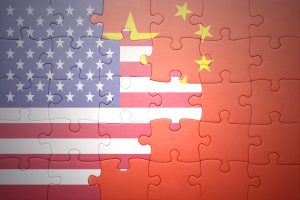On May 27, the Biden administration’s trade representative had her first interaction with a Chinese official. U.S. Trade Representative Katherine Tai had a phone call with Chinese Vice Premier Liu He, China’s top representative in past trade talks with the United States. Most famously, Liu sat down beside then-President Donald Trump to sign the “Phase One” trade agreement between China and the United States in January 2020.
The Liu-Tai call was one of just a handful of direct bilateral engagements between Biden administration officials and their Chinese counterparts – highlighted by an in-person meeting in March bringing together U.S. Secretary of State Antony Blinken, U.S. National Security Advisor Jake Sullivan, Director of the Chinese Communist Party’s Foreign Affairs Commission Yang Jiechi, and Chinese Foreign Minister Wang Yi. U.S. Defense Secretary Lloyd Austin reportedly has reached out to China about a meeting without any response.
Few details were immediately apparent after the phone conversation between Liu and Tai. According to the Chinese Foreign Ministry, “The two sides were engaged in candid, pragmatic and constructive communication with an attitude of equality and mutual respect. Believing that bilateral trade is of great significance, the two sides exchanged views on issues of common concern, and agreed to keep in contact.” That was essentially identical to the brief Chinese-langue summary from the Commerce Ministry.
The readout from the Office of the U.S. Trade Representatives was just as short and vague. The USTR also called the talks “candid,” adding that “Ambassador Tai discussed the guiding principles of the Biden-Harris Administration’s worker-centered trade policy and her ongoing review of the U.S.-China trade relationship, while also raising issues of concern.”
While the release did not go into detail, there is plenty of room for friction between the United States and China over the Biden administration’s trade agenda. According to a USTR factsheet issued earlier this year, the “worker-centered” trade policy promises to “protect and empower workers, drive wage growth, and lead to better economic outcomes for all Americans.” That raises the specter of the previous Trump administration’s repeated accusations that China has been “stealing” American jobs. Beijing will also be wary of the USTR’s stated focus on fighting “forced labor and exploitative labor conditions,” a particularly fraught issue for China as it intersects with charges of abuses against the Uyghurs and other ethnic minority groups native to Xinjiang.
Presumably at the very top of the list of Chinese concerns, however, would be the Trump era tariffs on Chinese goods, which remain in place despite the change in administration. The Phase One trade deal reached back in January 2020 did not include a roll-back of those tariffs, which at last count covered 66.4 percent of Chinese exports to the U.S., according to data from the Peterson Institute for International Economics. China’s retaliatory tariffs apply to 58.3 percent of U.S. exports to China. Overall, the U.S. had an average tariff rate of 19.3 percent on Chinese goods, compared to just 3 percent on exports from the rest of the world. China had a similar average tariff rate of 20.7 percent on U.S. goods, versus just 6.1 percent on exports from the rest of the world.
As I wrote for The Diplomat Magazine this month, the trade tensions that dominated the China-U.S. conversation during the Trump administration have noticeably faded in prominence on the bilateral agenda, replaced by concerns over human rights (particularly the oppression of Uyghurs in western China) and security worries, specifically the Taiwan Strait. Meanwhile, what economic conversation there is has shifted from bilateral barbs over tariffs and alleged trade abuses to a U.S. focus on engaging with partners on issues like advancing critical technology and keeping supply chains flowing. The Biden administration has stated that it wants to reach a united front with allies before engaging China in substantive trade discussions.
The USTR read-out added that Tai “looks forward to future discussions with Vice Premier Liu,” matching Chinese references to the parties agreeing to “keep in contact.” There were no specifics on when to expect a future conversation.
Meanwhile, however, subnational economic cooperation continues apace. An Economic and Trade Cooperation Forum between Chinese provinces and U.S. states was held on May 22. According to China’s Commerce Ministry, the meeting involved “about 150 local government representatives and business people from Chinese provinces and cities including Shanxi, Hunan, Jiangxi, Hubei, Jiangsu, Heilongjiang, Zhejiang and Tianjin, as well as U.S. states and cities, including the State of California, the State of New York, the State of Iowa and the City of Chicago.”
































